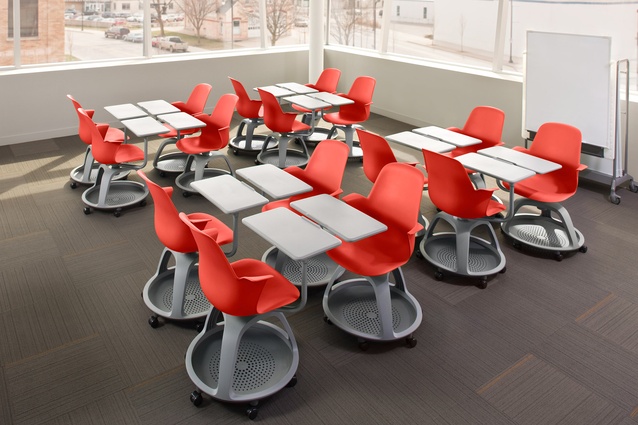How classroom design affects student engagement
Partner Content: A Steelcase study about the relationship and implications of student engagement and spaces for learning.
THE RESEARCH TEAM

Data from ongoing Steelcase Education studies shows that classrooms designed for active learning — i.e., where physical space supports a focus on engaging experiences for students and faculty — have a significant effect on student engagement.
Improving educational outcomes is a nearly universal goal, but how to achieve it remains a focus of continuing research and debate.
The success of any student is influenced by many variables. Academic studies have investigated several of them, from socio economic background to internal motivation to the influence of different teaching styles. Still often overlooked or underemphasized is the role of classroom design.
Noteworthy studies have been completed in recent years that show factors in the built environment can affect retention, attention, motivation, learning and academic achievement, but there have not been reliable post-occupancy evaluations of how different classroom designs affect student success. To address this important gap, a team of Steelcase Education researchers, in collaboration with academic researchers in Canada and the United States, recently completed studies at four U.S. universities. A robust survey instrument, titled the Active Learning Post Occupancy Evaluation (AL-POE) tool, was developed specifically for measuring the impact of classroom design on student engagement. Engagement is widely recognized as a highly probable predictor of student success.
The results of the beta study and the following term’s aggregated data revealed that classrooms intentionally designed to support active learning increased student engagement on multiple measures as compared to traditional (i.e., row- by-column seating) classrooms.
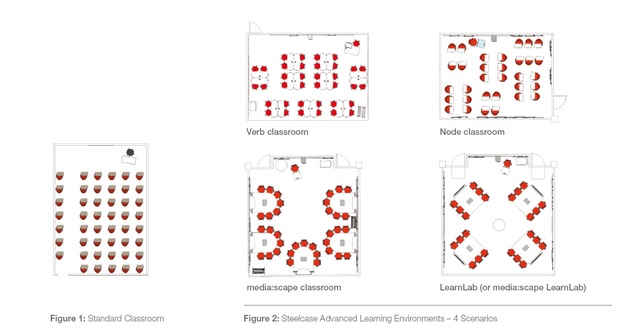
EXTENDING WHAT’S KNOWN
Sociological and environment behavioral research has established the impact of built environments on various behaviors: territoriality, crowding, situational and personal space. More recently researchers have explored how a learning environment impacts students. The consensus is that learning spaces have physical, social and psychological effects. The Steelcase Education research program was undertaken to build upon and contribute to this growing body of evidence that the learning environment impacts students’ success and engagement is a key predicting factor.
THE APPROACH: AN ACTIVE LEARNING POST-OCCUPANCY EVALUATION SURVEY
The research was designed to analyze student engagement across multiple measures by asking participants to compare their experiences in a traditional /standard classroom with row-by-columnseating – “pre/old” – (see figure 1: standard classroom) to what they experienced in a classroom intentionally designed for active learning — i.e., where physical space supports a focus on engaging experiences for students and faculty – “post/new” – (see figure 2: Steelcase Advanced Learning Environments). The AL-POE instrument showed these figures to orient the participant.
The active learning classrooms were furnished with Steelcase’s products and applications for active learning settings: Node seating, Verb, media:scape and LearnLab™. To determine a relationship between classroom design and the behavioral factors of student engagement, participating faculty members did not receive training from Steelcase on active learning practices. The settings were simply provided for their use as they saw fit.
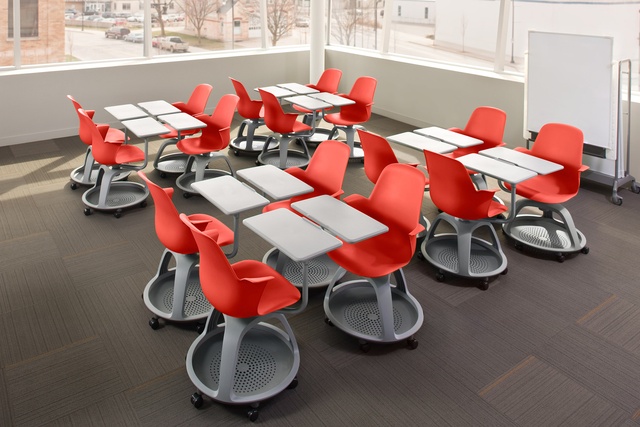
Using a two-step decision-making research method, student and faculty participants simultaneously evaluated their experience in the active learning setting and their previous experience in the traditional classroom; specifically they compared the “pre/old” and “post/new” settings for each metric.
Knowing that a robust and reliable tool is key to meaningful, consistent measurement, the research team used a rigorous content analysis process to create the AL-POE questions, synthesizing information from multiple resources including the 2012 National Survey of Student Engagement and published studies in brain science, brain-compatible classrooms, learning research and the impact of classroom design. The external institutional review board, Heartland, reviewed and approved the study’s research protocol.
The main body of the resulting evaluation has two sections. section I (practices) focuses on active learning practices that elicit engagement in the learning space. Section II (solutions) measures the effect of the classroom design on these active learning practices. Twelve measurement factors are consistent across the two sections, including:
- collaboration
- focus
- active involvement
- opportunity to engage
- repeated exposure to material through multiple means
- in-class feedback
- real-life scenarios
- ability to engage ways of learning best
- physical movement
- stimulation
- feeling comfortable to participate
- creation of an enriching experience
Another set of questions uses a five-point Likert scale to determine perceptions of grades, retention, overall engagement and ability to be creative. Open-ended comments are solicited as a final component of the survey tool. Respondents completed the survey online approximately 6-8 weeks into the term so they had enough time to establish a rhythm of using the space.
RESULTS: ACTIVE LEARNING CLASSROOMS HAVE A POSITIVE IMPACT ON STUDENT ENGAGEMENT
The combined studies results yielded major findings, all supporting a highly positive and statistically significant impact of active learning classrooms on student engagement:
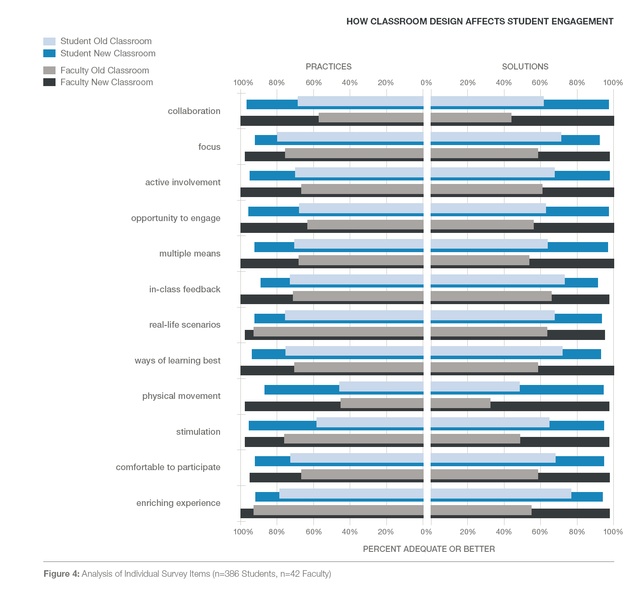
1) In the universities studied, participants reported that the new classrooms improved active learning practices and had more positive impact on engagement compared to the old classrooms. There were no significant differences in results among participating universities, strengthening the applicability of the findings.
2) The majority of students rated the new classroom better than the old classroom on each of the 12 factors. For all of the items in both sections of the evaluation, the differences between old/ pre and new/post ratings were highly statistically significant (p<0.001) for both faculty and students (see figure 4).
3) Overall, active learning practices and the impact of the physical space significantly improved in the new classrooms for both students and faculty. In the practices section, average composite scores rose from 23.2 (old/ pre) to 34.2 (new/post) for students, and from 24.0 (old/pre) to 37.3 (new/post) for faculty. In the solutions section, average composite scores rose from 21.8 (old/ pre) to 35.5 (new/post) for students and from 19.1 (old/pre) to 38.8 (new/ post) for faculty. See figures 5 and 6.
4) The majority of students and faculty reported that the new classrooms contributed to higher engagement, the expectation of better grades, more motivation and more creativity. A large majority of students self-reported a moderate to exceptional increase in their engagement (84%), ability to achieve a higher grade (72%), motivation to attend class (72%), and ability to be creative (77%). Almost all faculty members reported a moderate to exceptional increase in student engagement (98%), and all perceived a moderate to exceptional increase in student’s ability to be creative (100%). A large majority of faculty reported a moderate to exceptional increase in students’ ability to achieve a higher grade (68%), and a moderate to exceptional increase in students’ motivation to attend class (88%). See figure 7.
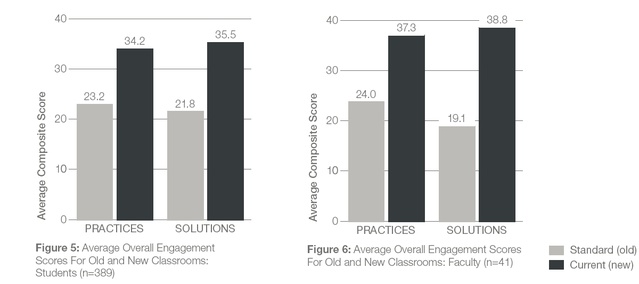
THE BOTTOM LINE: INTENTIONALLY DESIGNING SPACES PROVIDES FOR MORE EFFECTIVE TEACHING AND LEARNING
As a result of the development of the evaluation instrument and this managed research program, decision makers at educational institutions, architects and designers can be assured that investments in solutions intentionally designed to support active learning can create more effective classrooms and higher student engagement. Furthermore, there’s now evidence that these classrooms encourage and enable educators to practice active learning methods. Faculty development is still recommended to understand how to leverage the space as a tool for learning.
The study also underscores the importance of designing products for educational environments based on insights from rigorous research. All the products used in the new/post classrooms were developed from Steelcase’s human-centered research process methodology, and this study validates that the evidence-based design protocol helps produce measurable results in use.
The Steelcase AL-POE tool developed for this study can now be used to reliably measure the impact of engagement in learning environments, adding to the body of knowledge about the relationship and implications of student engagement and spaces for learning.
Steelcase is continuing this managed research project to build data and gain new insights into how educational environments can be designed and equipped to optimize learning.
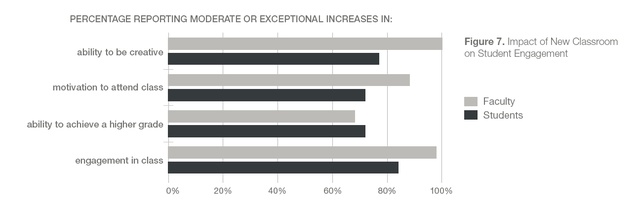
TWO STUDY PARTICIPANTS SHARE KEY INSIGHTS:
“Instead of doing multi-year studies and piloting different approaches, for which we do not have time, we were able to implement proven active learning solutions by leveraging Steelcase Education’s expertise. They are an important partner in proposing and modifying solutions that prove impactful on teaching and learning.” — Michael Olsen, Former director of information technology and biosciences and research, University of Minnesota Rochester
“The ongoing research study conducted here by Steelcase Education revealed a statistical significance in terms of student engagement between our Interactive Learning Space and traditional classroom layouts. This revelation was a shared perspective from both faculty and students.” — Gary Pavlechko, director, teaching technology, Office of Educational Excellence at Ball State University
RESEARCH COLLABORATORS:
- Roger Konyndyk, Ph.D., Statistician, Steelcase Inc., Grand Rapids, Michigan
- Kris Magnusson, Ph.D., Dean of Education, Simon Fraser University, British Columbia, Canada
- Bryan Hiebert, Ph.D., Associate Professor, Education Psychology & Leadership, University of Victoria, British Columbia, Canada
REFERENCES
Altman, I. (1970). Territorial behavior in humans. An analysis of the concept. In Spatial behavior of older people. Edited by Leon Pastalan and Dan Carson. MI: The University of Michigan. 1-24.
Altman, I. (1975). The environment and social behavior. CA: Wadsworth. Appleton, J., Christenson, S., & Furlong, M. (2008). Student engagement with school: critical conceptual and methodological issues of the construct. Psychology in the Schools, 45(5), 369-386.
Blincoe, J. (2008). The age and condition of Texas high schools as related to student academic achievement. (Doctoral Dissertation). Retrieved from ProQuest. (AAT 3341554).
Durán-Narucki, V. (2008). School building condition, school attendance and academic achievement in New York City public schools: A mediation model. Journal of Environmental Psychology, 28, 278-286.
Earthman, G. I. (2004). Prioritization of 31 criteria for school building adequacy. Baltimore, MD: American Civil Liberties Union Foundation of Maryland.
Erlauer, L (2003). The brain compatible classroom: Using what we know about learning to improve teaching. Alexandria, VA: Association for Supervision and Curriculum Development.
Gadermann, A.M., Guhn, M. and Zumbo, B.D. (2012). Estimating ordinal reliability for Likert-type and ordinal item response data: A conceptual, empirical, and practical guide. Practical Assessment, Research and Evaluation, 17(3). Retrieved Sept. 25, 2012 from http://pareonline.net/pdf/v17n3.pdf.
Hall, E.T. (1966). The hidden dimension. NY: Doubleday Press.
Hiebert, B. (2012). Post-Pre Assessment: An innovative way for documenting client change. Guidance Perspectives Around the World. Available from:
http://iaevg.org/crc/resources.cfm?subcat=200,202&lang=en [Accessed 26 October 2013].
Jankowska, M (2007). Use of creative space in enhancing students’ engagement. Innovations in Educations and Teaching International. 45(3), 271-279.
Jensen, E (2005). Teaching with the brain in mind, 2nd edition. Alexandria, VA: Association for Supervision and Curriculum Development.
Kahu, E, (2011), Framing student engagement in higher education. Studies in Higher Education, DOI: 10.1080/03075079.2011.598505.
Kumar, R., O’Malley, P. & Johnston, L.(2008) Association between physical environment of secondary schools and student problem behavior – A national study, 2000-2003. Environment and Behavior, 40(4), 455-486.
National Survey of Student Engagement. (2012). Promoting student learning and institutional improvement: lessons from NSSE at 13. Bloomington, IN: Indiana University Center for Postsecondary Research.
Schneider, M. (2002). Do school facilities affect academic outcome? National Clearinghouse for Educational Facilities. Retrieved from http://www.ncef.org/pubs/outcomes.pdf on 5 October 2010.
Scott-Webber, L., Strickland, A., & Kapitula, L. (2013). Built environments impact behaviors: results of an active learning post-occupancy evaluation. Planning for Higher Education, Vol, 41(5).
Scott-Webber, L., Marini, M., & Abraham, J. (2000, Spring). Higher education classrooms fail to meet needs of faculty and students. Journal
of Interior Design, 26(1), 16-34.
Sommer, R. (1969). Personal space: The behavioral basis of design. Englewood Cliffs, NJ: Prentice Hall.
Sommer, R. (1970). Studies of small group ecology. In RS Catheart & LA Samovar (Eds.) Small group communication. Dubuque, IA: Wm. C. Brown.

